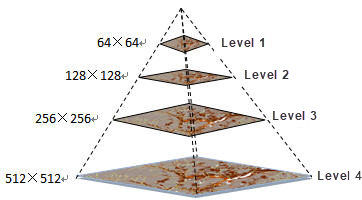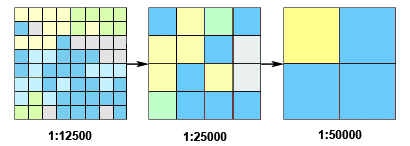The image pyramid is a collection of images generated at a series of resolutions from fine to coarse according to specific rules. The image pyramid technique uses resampling methods to create a series of image layers at different resolutions. Each layer is stored separately, with a corresponding spatial index mechanism established to improve the display speed when zooming in or out on images.
As shown in the figure below, the image pyramid starts with the original highest resolution image at the base, with a resolution of 512×512 pixels. As the layers ascend, the resolution decreases to 256×256, 128×128, and finally, 64×64 at the top of the pyramid. This image pyramid has four layers, representing four resolution levels. Clearly, the higher the image resolution, the more levels the image pyramid will have. For an image with a resolution of 2a×2b (a > b), SuperMap will create (b-6)+1 layers of the pyramid.
 |
| Figure: Image Pyramid |
Once an image pyramid is created for an image, every time the image is browsed, the system will retrieve its image pyramid for display. When you zoom in or out on the image, the system will automatically select the most appropriate pyramid level based on the display scale to render the image.
Pyramids can only be created for original data. A pyramid can be created for one dataset at a time. If you want to create a pyramid again, the existing one must be deleted. When browsing the raster dataset after the image pyramid has been created, you are essentially accessing the already created pyramid. The figure below illustrates the process of building pyramids at different scales.
 |
Creating an image pyramid can significantly improve the rendering speed and performance of zooming in and out of images. However, it also increases the storage space required for the dataset, enlarging the datasource file containing the image dataset. This is because the created image pyramid is essentially a collection of images at different resolutions, all stored together with the data in the datasource file, thereby increasing its size. Additionally, the larger the raster dataset, the longer it takes to build the pyramid and the larger the storage space required for the image pyramid. However, it saves considerable time during subsequent image browsing. Therefore, for massive image data, creating a pyramid is an effective choice to optimize efficiency.
The SuperMap SIT image file format (obsolete) integrates image compression and efficient image pyramid technology, enabling ultra-fast image data display, largely independent of the image data size. Even on low-performance machines, massive image data can be displayed smoothly.
Related topics



